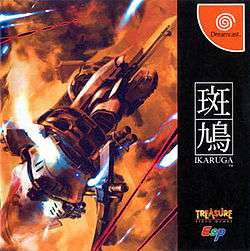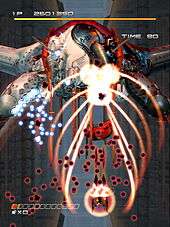Ikaruga
| Ikaruga | |
|---|---|
 Japanese Dreamcast box art | |
| Developer(s) | Treasure |
| Publisher(s) |
|
| Director(s) | Hiroshi Iuchi |
| Producer(s) | Masato Maegawa |
| Designer(s) | Yasushi Suzuki |
| Programmer(s) | Atsutomo Nakagawa |
| Composer(s) | Hiroshi Iuchi |
| Platform(s) | Arcade, Dreamcast, GameCube, Xbox 360, Android, Windows |
| Release date(s) | |
| Genre(s) | Shoot 'em up |
| Mode(s) | Single-player, 2-player cooperative |
| Cabinet | Upright |
| Arcade system | Sega NAOMI |
| Display | Raster (Vertical) |
Ikaruga (斑鳩, lit. Japanese grosbeak) is a vertical manic shoot 'em up video game developed and published by Treasure. It was originally released in Japanese arcades in 2001 on the Sega NAOMI platform, and is the spiritual sequel to Radiant Silvergun. The gameplay consists primarily of a polarity mechanic. All enemies and bullets in the game are either black or white, and the player may switch between these polarities at will. Bullets which are the same color as the player are absorbed while the other will kill the player. The game features both single-player and cooperative modes.
Ikaruga was developed with a core team of only three people for over two years. All the characters and enemies in the game were named after various bird species. The game was well received by critics and is considered one of the best shoot 'em up games of all time. Ikaruga was ported to consoles first in Japan on the Dreamcast in 2002, and then worldwide on the GameCube in 2003. An enhanced port was released for the Xbox 360 in 2008 and later ported to Microsoft Windows in 2014.
Many of the ships in the game are named after bird species. Ikaruga (斑鳩), the titular ship which is controlled by player one, is named for the Japanese grosbeak. The name of player two's ship, Ginkei (銀鶏), refers to the Lady Amherst's pheasant.
Gameplay

Ikaruga's gameplay centers primarily around the polarity mechanic. Only bullets of an opposite polarity can kill the player. Same-color bullets are absorbed and converted into energy for the game's special weapon, a homing laser. Switching the ship's polarity also changes the color of the ship's bullets, and shooting an enemy using opposite-polarity bullets will cause double damage. Thus, much of the challenge of Ikaruga comes from careful polarity-switching, choosing between high damage and (relative) invulnerability. This is especially true when fighting bosses, as they often fire bullets of both colors in overlapping patterns. The game also presents navigational challenges where the player must maneuver through continual streams of weapons fire, using their shields to absorb one color while avoiding the others.
Skilled players may also perform combination "chains" for points. A chain occurs when three enemies of the same polarity are destroyed consecutively. The more sets of three enemies that are dispatched in a row, the more points are acquired, eventually rewarding the player with an extra chance/life. On the opposite end of the spectrum is the entirely original "bullet eater" or "dot eater" strategy, wherein the player does not shoot enemies, including bosses, which retreat after a set period.
Despite the fact that only four people are responsible for its creation, Ikaruga features full three-dimensional landscapes and a soundtrack. The home console releases also feature TATE mode - the ability to rotate the game's display by ninety degrees while the player's monitor rests on its left side, for full-screen arcade size. This same mode can be used without rotating the monitor by configuring the controls, in essence changing the game from a vertical scrolling shooter to a horizontal one. When the game is played with the display in a normal orientation (YOKO mode), the sides of the screen are blank because the game field itself is taller than it is wide. If it is turned on its side, it can take up the whole screen and still have the same aspect ratio. An interesting feature of the arcade release, which is also included in the home formats, is the 'Trial Game' mode, where infinite lives are awarded for a single credit on the first level, but only the first two chapters of the game can be played, offering a good way to practice.
In addition, Ikaruga features a two-player simultaneous mode, an in-depth slow-motion tutorial mode, with stage tutorials becoming accessible to players who reach them in the main game, and an in-game art gallery featuring character and mechanical designs by Yasushi Suzuki, who did designs for Treasure's Sin and Punishment: Hoshi no Keishōsha for the Nintendo 64.
Plot
Several years ago in the small island nation of Horai, the leader of the nation, Tenro Horai, discovered the Ubusunagami Okinokai—the Power of the Gods. This energy emanated from an object she dug up from deep underground and granted her unimaginable powers. Soon after, Tenro and her followers, who called themselves "The Divine Ones", began conquering nations one after another. "The Chosen People" carried out these conquests in "the name of peace". Meanwhile, a freedom federation called Tenkaku emerged to challenge Horai. Using fighter planes called Hitekkai, they fought with the hope of freeing the world from the grips of the Horai - but all their efforts were in vain. They were no match for the Horai and were eventually almost completely wiped out. Miraculously, however, one young man survived. His name was Shinra (森羅).
Shot down near a remote village called Ikaruga, inhabited by elderly people who had been exiled by the Horai's conquests, Shinra was dragged from the wreckage and nursed back to health. Shinra regained his health and pledged to defeat the Horai, and the villagers entrusted him with a fighter plane that they had built themselves, called the Ikaruga. The Ikaruga was no ordinary plane, designed by former engineering genius Amanai (天内) with the help of Kazamori (風守) and the village leaders. Hidden in a secret underground bunker and launched via the transportation device called the "Sword of Acala", it is the first fighter built that integrates both energy polarities, and is capable of successfully switching between the two. In a two-player game, Shinra is joined by Kagari (篝), a mercenary of Horai defeated by Shinra. After Shinra spared her life, she decided to change sides and join the resistance. Her ship, Ginkei, is modified by the people of Ikaruga to give it identical capabilities to Shinra's ship.
Development and release
Ikaruga was developed by a core team of only three people at Treasure Co. Ltd led by lead game designer, BG graphic designer and music composer Hiroshi Iuchi, along with programmer Atsutomo Nakagawa, and illustrator and character/object designer, Yasushi Suzuki.[1] G.rev, then an upstart company attempting to raise funds to develop Border Down, provided several supporting team members on a contract basis. Development was long by arcade shooter standards, with over two years spent in development. Ikaruga was the first game for which Treasure released an official "Superplay" video, the Ikaruga Appreciate DVD, before Konami released the Gradius V "Options" and "Perfect" DVDs in 2004. The print run for the Dreamcast version was a very limited 50,000 copies, distributed only in Japan. For this reason, the Dreamcast version is considered rare and fetches high prices on internet auctions.
An Xbox Live Arcade version was released on April 9, 2008, and included online multiplayer co-op, leaderboards, and two screen modes (horizontal/pillarboxed and vertical) supported.[2] A version for Taito's NESiCAxLive arcade digital distribution system was released on August 8, 2013 which included a 3-button control mode an supported 3 different game modes (arcade, prototype, chapter select). In October 2013, Treasure placed the title on the Steam Greenlight process to bring the game (based on the Xbox 360 version) to Microsoft Windows, with hopes to bring their other titles to the platform later.[3]
Reception and legacy
| Reception | |||||||||||||||||||||||||||||||||||||||||||
|---|---|---|---|---|---|---|---|---|---|---|---|---|---|---|---|---|---|---|---|---|---|---|---|---|---|---|---|---|---|---|---|---|---|---|---|---|---|---|---|---|---|---|---|
| |||||||||||||||||||||||||||||||||||||||||||
Although it garnered modest sales, it is among the most successful and recognized arcade shooter ports of the 2000s. GameRankings places the average review score for Ikaruga at 86%.[17] Metacritic gives the Gamecube version a metascore of 85/100.[18] On release, Weekly Famitsu magazine scored the Dreamcast version of Ikaruga a 36 out of 40,[19] and in its first week (2002/9/2–8) the game sold about 18,596 units to debut 5th on the magazine's "Top 30". The following week it dropped off the chart. In its first week (2003/1/13–19), the Gamecube version of Ikaruga debuted at number 20. It sold about 6,916 units. By the next week, it dropped off the chart. ScrewAttack voted Ikaruga the 2nd greatest 2D shooter of all time,[20] while IGN voted it the 3rd greatest.[21] ScrewAttack also declared it #9 on Top Ten GameCube Games, along with Gametrailers rating it #5 on Top Ten Most Difficult Games.
Though the official online scoreboard is now defunct, players to this day exchange high scores and game play videos in online forums.[22] Ikaruga was used in Trial Mode as a competition between two 2-player teams for the Final Round of the Omegathon at PAX East 2011. Another testament to Ikaruga's enduring popularity are the model kits created by Japanese model manufacturer Kotobukiya. Three models of the Ikaruga have been released, and in September 2012, the second-player ship, Ginkei, was made available.[23]
References
- ↑ "Ikaruga credits".
- ↑ "Official Ikaruga Xbox.com page". Microsoft.
- ↑ Yin-Poole, Wesley (October 4, 2013). "Ikaruga hits Steam Greenlight". Eurogamer. Retrieved October 4, 2013.
- ↑ http://www.computerandvideogames.com/179316/reviews/ikaruga-review/
- ↑ http://www.eurogamer.net/articles/r_ikaruga_gc
- ↑ http://www.eurogamer.net/articles/ikaruga-review
- ↑ http://ca.ign.com/articles/2003/04/09/ikaruga-3
- ↑ http://ca.ign.com/articles/2008/04/07/ikaruga-review
- ↑ http://www.pcgamer.com/ikaruga-review/
- ↑ http://metro.co.uk/2014/02/20/ikaruga-pc-review-black-and-white-issue-4311748/
- ↑ "Ikaruga for GameCube". GameRankings. Retrieved February 14, 2015.
- ↑ "Ikaruga for PC". GameRankings. Retrieved February 14, 2015.
- ↑ "Ikaruga for Xbox 360". GameRankings. Retrieved February 14, 2015.
- ↑ "Ikaruga for GameCube Reviews". Metacritic. Retrieved February 14, 2015.
- ↑ "Ikaruga for PC Reviews". Metacritic. Retrieved February 14, 2015.
- ↑ "Ikaruga for Xbox 360 Reviews". Metacritic. Retrieved February 14, 2015.
- ↑ "Ikaruga". GameRankings. Retrieved 2007-03-24.
- ↑ "Ikaruga Reviews". Metacritic. Retrieved 2007-04-05.
- ↑ ドリームキャスト - 斑鳩 IKARUGA. Weekly Famitsu. No.915 Pt.2. Pg.49. 30 June 2006.
- ↑ "Gametrailers.com - ScrewAttack - Top Ten 2-D Shooters". ScrewAttack's Top 10.
- ↑ "Top 10 Tuesday: 2D Space Shooters". The IGN News & Features Team. IGN. Retrieved 2013-06-28.
- ↑ "Ikaruga.co.uk".
- ↑ "飛鉄塊 銀鶏 [白]". KOTOBUKIYA.
External links
- Official websites for Arcade, Dreamcast, and NESiCAxLive versions (Japanese)
- Taito's NESiCAxLive page
- Ikaruga at the Killer List of Videogames